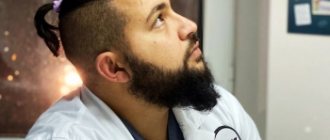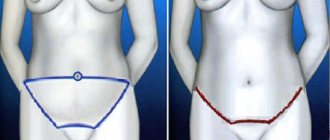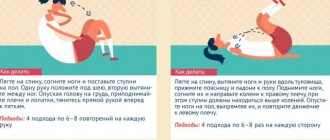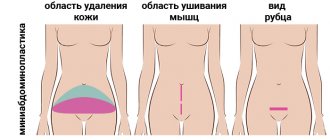Abdominoplasty (abdominoplasty) is a plastic surgery that is performed to eliminate excess skin and fat deposits in the area of the anterior abdominal wall, to solve the problem of discrepancy of the rectus abdominal muscles and to model the aesthetically correct proportions of the abdominal wall.
The need for a full abdominoplasty arises with significant changes in fatty tissue and skin in the abdominal area, with aponeurosis of the anterior abdominal wall, when special dietary nutrition systems and sports activities do not make it possible to eliminate tissue changes in the abdominal area. If indicated, the plastic surgeon performs abdominoplasty with transposition of the umbilical ring and elimination of diastasis of the rectus abdominis muscles.
Indications for abdominoplasty
With a sharp change in weight, after childbirth or complex surgical operations, significant deformation of the abdominal tissues can occur, the elimination of which in most cases is impossible without the help of a plastic surgeon. Abdominoplasty is needed if the following indications exist:
- diastasis (divergence) of the rectus abdominal muscles ;
- skin-fat apron , formed when there is an excess of skin and fatty tissue;
- cicatricial deformation of the abdominal area after surgery;
- pronounced ptosis (sagging) of the skin in the abdominal area;
- stretch marks (stretch marks) on the abdomen in women after childbirth.
Abdominoplasty can be performed simultaneously with liposuction if excess fat deposits in problem areas need to be eliminated. Both operations will not help solve the problem of obesity and excess weight, but with their help you can successfully correct the contours of the abdomen and create more aesthetic waist proportions.
Abdominoplasty methods
Depending on the type of indication, the following operations are performed:
- removal of the skin-fat apron , which allows you to eliminate excess skin and fatty tissue in the abdominal area,
- lipomodeling of the upper flap (above the navel),
- lipomodeling of the lower flap (above the pubic area),
- elimination of diastasis (divergence) of the rectus muscles using plastic surgery of the white line of the abdomen,
- abdominoplasty with navel (transposition) .
To perform a complete abdominoplasty, Vardan Robertovich uses his bloodless, low-traumatic technique, through which a special complex design of internal sutures is formed.
The advantageous feature of the method is that the scar is as thin as possible and is located as low as possible in the bikini area; there is no need for postoperative care and subsequent removal of sutures. Patients call the method “sutureless abdominoplasty” because there are no stitches in the skin. The precision, delicate technique of Vardan Robertovich can reduce rehabilitation time by several times.
How is abdominoplasty performed?
Vardan Robertovich performs complete abdominoplasty under general anesthesia (Sevoran). The surgeon believes that correct correction of the linea alba is the foundation of abdominoplasty.
Before the operation, special markings with symbols are made. To lower the incision as low as possible, the surgeon uses a special system for stretching and redistributing the flap. During the operation, the flap is mobilized and the linea alba is corrected while preserving the blood supply and the umbilical ring.
After removing excess skin and fatty tissue, the integrity of the tissue is restored layer by layer and with maximum precision, which makes it possible in the future to do without visible external sutures on postoperative wounds. All main structures are built using a special proprietary technology inside: Vardan Robertovich creates a unique seam in the form of a DNA molecule. This is a two-story spiral seam, where the first floor overlaps the second, so the fabrics are securely fixed from the inside.
To create a new navel, the surgeon contours the upper flap to create a small depression in the midline area of the abdomen around the navel. If necessary, the pubic area is corrected using the method of lipectomy or liposuction, which may be necessary to obtain a harmonious ratio of the proportions of the contours of the upper flap and the pubic area.
Rehabilitation recovery after surgery
- Instead of bandages and strips, Vardan Robert uses skin glue. The glue comes off on its own within 2-3 weeks.
- The patient may shower for the first time hours after surgery.
- After abdominoplasty using his original method, there are no stitches left on the skin and, therefore, the patient does not need special care or removal of stitches.
- Discharge is possible in 1-2 days.
- The patient returns to his usual rhythm of life after 2-3 weeks, but he will be able to evaluate the final result of abdominoplasty with navel transfer after 6 months.
After abdominoplasty, it is recommended to adhere to certain restrictions: temporarily reduce physical activity, refuse a hot shower, visit a bathhouse, sauna. If you follow all the instructions from your plastic surgeon, complications will be unlikely. No special postoperative observation is needed.
Abdominoplasty result
- a beautiful, toned stomach with a neat natural depression in the navel area;
- the thinnest low cut line under the underwear;
- absence of excess skin at the edges of the incision;
- no visible scar around the navel;
- minimal risk of complications due to the use of a low-traumatic proprietary technique.
Contraindications to abdominoplasty
The operation is unacceptable if the patient has contraindications:
- acute infectious processes;
- blood clotting disorder;
- pulmonary failure;
- heart failure;
- malignant formations;
- diabetes;
- some chronic diseases in the acute stage;
- pregnancy, recent childbirth.
More complete information about full abdominoplasty and its cost can be obtained from the administrator.
Abdominoplasty: all the nuances from an expert
A slender body and a beautiful figure are the aesthetic ideal of female beauty of our era. In our understanding, a flat stomach, slender waist and toned body look beautiful and attractive. There are a large number of ways to achieve this goal. However, it is not always possible to achieve the desired result. If, for various reasons, you still cannot get rid of a protruding belly or excess skin, abdominoplasty comes to the rescue.
We talked about the features of this operation and its types of operation with the plastic surgeon of the Mont Blanc plastic surgery clinic - Sarvar Kazimovich Bakirkhanov.
Sarvar Kazimovich, as far as I know, in addition to classical abdominoplasty, there is also endoscopic and mini-abdominoplasty. What is the fundamental difference between them and how to understand for what indications one or another operation is performed?
The type of operation each patient needs is determined by the surgeon himself. It all depends on the degree of excess soft tissue of the abdomen, that is, skin and subcutaneous fat. Mini abdominoplasty is used if there is excess skin below the navel, provided that there is no excess tissue above the navel and the tummy is flat. If there is excess skin above the navel, then a classic abdominoplasty is performed, which consists of truncation of the skin under the navel with the formation and mobilization of the skin from the navel to the pubic area and the removal of the navel in a new place.
The term “endoscopic abdominoplasty” is not entirely correct; it is rather endoscopic stitching, plication of the aponeurosis of the abdominal muscles, which is carried out using a small incision along the navel ring in case of a defect in the anterior abdominal wall. During this operation, under the control of an endoscope, staples are applied to tighten the aponeurosis. Let me emphasize once again that this is done when there is no excess skin, when the tummy is flat, but it protrudes due to a weak aponeurosis or the presence of a hernia. That is, during this operation, the internal frame of the anterior abdominal wall, consisting of the aponeurosis of the rectus abdominis muscles, is tightened. By installing braces, the stomach becomes flat. After this operation, the patient should avoid heavy lifting and stress on the abdominal muscles for one and a half months.
Tell me, is it true that abdominoplasty can remove hernias of the anterior abdominal wall?
Hernias must be removed during abdominoplasty. If this concerns a hernia of the white line of the abdomen or ventral hernias, then of course we solve these problems in one operation. When performing a classic abdominoplasty, a skin-fat flap is mobilized, then the hernial gate is opened, the hernial contents are placed in the abdominal cavity and the hernial sac is excised.
Then plastic surgery is done using one’s own tissues, if the woman is a young girl and childbirth is expected, or if the woman will no longer give birth, a mesh implant is installed.
What is this implant?
The implant looks like a thin mosquito net. It is made of special medical material. Now there are even new generation meshes, biodegradable, which, having fulfilled their frame function, dissolve within three months. The first time after its installation, you need to give rest to the abdominal muscles, and then the mesh will take root well. The implant provides a 100% guarantee that the hernia will not recur in the future. But the decision to install it depends on the patient’s age and the possibility of childbirth in the future, since if the patient plans to give birth, a synthetic implant cannot be installed.
Tell me, is there any point in performing abdominoplasty before childbirth? Or is it better after?
There are two things to keep in mind when performing abdominoplasty. Firstly, this operation, of course, is best done after childbirth, because anyway, during pregnancy, the anterior abdominal wall will be stretched and the geometry of the abdomen will change. And secondly, the operation can be performed only after the patient has reached her comfortable weight. This is the basic rule. At the first consultation, I always ask patients if they are at the stage of losing weight, because in this case it is better to postpone the operation a little to avoid the formation of excess skin over the scar and, as a result, re-operation.
Are there any ways to prevent abdominal distension during pregnancy?
Certainly. Wearing a bandage during pregnancy supports the abdomen well and prevents an increase in the amount of amniotic fluid, and also helps the tissues stretch evenly. After childbirth, you need to actively maintain your abs. Wearing a bandage and exercises for the abdominal muscles give excellent results, because in the postpartum period there are powerful mechanisms for restoring the body, including muscle tissue. If a woman takes care of herself, she gets a nice flat tummy.
Sarvar Kazimovich, is there any difference between abdominoplasty in men and women?
The surgical technique is the same in both cases. The difference lies only in the types of obesity in men and women. Men rarely have a flabby belly. In them, the aponeurosis of the anterior abdominal muscles is stretched due to the so-called internal fat, which creates the “beer belly” effect. In men, subcutaneous fat is usually small, but there is an increase in adipose tissue in the abdominal cavity. Therefore, it is impossible to create a frame and make the stomach flat by reducing the aponeurosis in men.
In what cases is preference given to liposuction rather than abdominoplasty? After all, this is also a fairly popular operation today.
Liposuction is used when it is necessary to remove not excess skin, but to reduce the thickness of the fat layer. The surgeon must have a clear understanding of what exactly is suitable for the patient: abdominoplasty, if there is excess skin, or liposuction only. This largely depends on the age of the patient, since over time the skin begins to contract poorly, so reducing the fat layer can lead to the appearance of excess skin. Very often we simply combine these operations. For example, with abdominoplasty, it is advisable to perform liposuction of the lateral abdomen in order to achieve the best possible result. The surgeon should not follow the lead of patients, who are often well informed. It is necessary to take a very responsible approach to choosing one or another operation scheme.
Abdominoplasty is a fairly serious operation, please tell us how the rehabilitation period proceeds?
From a technical point of view, this operation is not difficult, but on the contrary, it is very interesting for the surgeon. However, during abdominoplasty, a rather large surgical field is allocated, so the operation is quite traumatic. Accordingly, the postoperative period is very important. After abdominoplasty, it is recommended to carry out infusion therapy to restore the salt balance in the body. The postoperative wound should also be monitored because even though the patient wears a compression garment after surgery, serous fluid may accumulate in the postoperative cavity. This is not a problem, this is the expected course of the post-operative period, but it needs to be monitored and evacuated. If necessary, liquid is removed from the wound cavity using a thin needle.
In general, the rehabilitation period takes about one and a half months. We apply an intradermal absorbable suture that will not need to be removed. You need to wear compression garments for a month; you can gradually return to sports after a month and a half. This time is enough for a good scar to form not only in the lower abdomen, in the bikini area, but also restraining scar tissue on the aponeurosis of the anterior abdominal muscles.
What is the technique of the intradermal suture that you mentioned?
The intradermal suture technique is used by many surgeons. What is important here is not so much the technique as the suture material itself. The use of expensive self-absorbable threads and silicone patches, creams, leads to the fact that the evolution of the scar becomes favorable, and a thinner scar is formed. So the main thing here is the suture material. We purchase expensive material from which you should not expect surprises. After the operation, one horizontal seam remains in the bikini area.
Please tell me, how often does the need for repeat abdominoplasty arise?
To avoid repeating the operation, the surgeon must observe two main points. Firstly, this is what we have already talked about: you need to choose the right moment for the operation, when the patient is at her comfortable weight. And secondly, you should avoid too much tension on the flap; it is so important not only not to under-tighten it, but also not to over-tighten it, thereby disrupting the blood flow.
Sarvar Kazimovich, thank you very much for your story!
We hope this information will be useful to all readers considering abdominoplasty. We wish you success! Consultation with a plastic surgeon at the Mont Blanc clinic is free! Make an appointment by phone. Waiting for you!
How to remove a scar after abdominoplasty?
If the scar is not aesthetically pleasing or causes significant discomfort, measures to reduce it may be required. Many patients, long before the operation, are concerned about whether the scar can be removed after abdominoplasty. Sometimes fear of scars can lead to refusal of surgery.
Unfortunately, you can independently influence the formation of the scar only during the first year. After its formation, the use of ointments and other external agents has virtually no effect on the appearance. However, it is still possible to make adjustments.
Depending on the specific problem, the following measures can be applied:
- Surgical excision of excess scar tissue. Used for rough and thick scars. Doesn't completely eliminate the problem, but allows you to achieve a neater look. At the same time, the scar itself remains visible.
- Changing scar color using fractional laser. By sealing the capillaries adjacent to the scar, significant lightening of the area is achieved.
- Laser resurfacing and chemical peeling. Used to improve the appearance of a normal, neat seam.
It is impossible to completely eliminate a scar even with the help of surgery. If, after all the manipulations, the patient is not satisfied with the way his scar looks after abdominoplasty, you can resort to a colored tattoo. This solution will not only hide the formed scar, but also add an original note that emphasizes the corrected attractive shape. Call our New Technologies clinic and get a modern approach, consultation and treatment.
RECOMMENDED:
- constantly wear a special support belt, which promotes rapid wound healing and prevents fluid accumulation;
- Eat a balanced diet, excluding foods and drinks that can cause excessive gas formation in the intestines. Also, for seven days after, you should not eat sweet foods;
- It is not advisable to smoke and drink alcoholic beverages;
- From the 6th day after surgery, you can shower, excluding any impact on the suture area. After water procedures, the seams can be blotted with a towel;
- During the postoperative period, you will be observed by your attending physician for at least 14 days. At this time, it is necessary to stay in the city so that you can contact a plastic surgeon if you have the slightest discomfort, severe pain or burning in the operated area.
Are there alternatives to a tummy tuck that are just as effective without anesthesia?
Many see liposuction as an alternative. However, there are several significant “buts” in this matter. In modern plastic surgery, it is possible to tighten muscles and remove excess excess skin only with the help of abdominoplasty. Liposuction can only remove some excess fat, and how the skin shrinks after this depends on each individual patient. There are also several non-invasive skin tightening methods - laser and ultrasound, which are performed without general anesthesia. However, when it comes to large amounts of sagging skin, these procedures may not be effective. Abdominoplasty can significantly narrow the waist and flatten the abdomen, while liposuction will only remove a small amount of volume from the sides and abdomen resulting from excess fat.
You can learn more about abdominoplasty in the “Tummy Tuck” section.
Who is a good candidate for abdominoplasty?
Good candidates for a tummy tuck will be those people who have excessive excess skin, loose muscles and some excess fat. This often happens after pregnancy. And it is advisable that after this, the woman does not plan to become pregnant again for several years. Since this can ruin the result, and the whole procedure will ultimately be useless. Thus, the best patients for this surgery are those whose weight is within 20% of their ideal body weight. Other good candidates are patients who have had significant weight loss, resulting in sagging skin that is difficult to get rid of.










